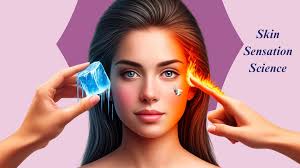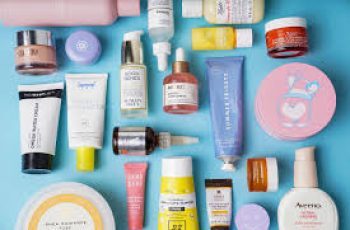
TRP Receptors and Skin Sensation
Have you ever wondered why certain skincare products cause a tingling, burning, or cooling sensation on your skin? The answer lies in a complex network of receptors found in your skin cells, known as transient receptor potential (TRP) channels. These fascinating proteins act as sensory gatekeepers, allowing your skin to detect and respond to various stimuli, including temperature, pH, and specific chemical compounds. In this blog post, we’ll dive into the captivating world of TRP receptors and explore how different skincare ingredients interact with these channels to create unique sensations and deliver targeted skin benefits.
How Skincare Ingredients Make Skin Feel Hot or Cold
In the intricate world of dermatology, transient receptor potential (TRP) channels have emerged as a fascinating area of study due to their ability to detect and respond to various environmental stimuli. Among these, the TRPV1 receptor is particularly notable for its role in perceiving heat, pain, and itch sensations or causing the skin to feel cool making it a central focus in understanding skin reactions to different stimuli.
The Role of TRP Receptors in Skin Sensitivity
TRP receptors are integral membrane proteins that play a crucial role in sensing and responding to environmental stimuli. In the skin, two key members of this family, TRPV1 and TRPV4, are particularly important in mediating sensations of heat, pain, and itching. TRPV1, for example, is activated by capsaicin, the pungent compound found in chili peppers, which explains why it is associated with the detection of burning heat and pain.
Interestingly, TRPV1 is also sensitive to changes in pH levels. This sensitivity is the reason why substances like lactic acid, commonly used in skincare products for its exfoliating properties, can cause a stinging sensation when applied to the skin. The intensity of this sensation can vary among individuals, depending on factors such as the integrity of their skin barrier and the density of TRP receptors in their skin. If you perceive stinging on her skin when lactic acid is applied, you are referred to a “Lactic acid stinger” in the dermatology world. Not everyone stings when lactic acid is applied, and there is much research to find out why some people are more likely to experience skin stinging than others.
How TRP Receptors Work
When a specific stimulus, such as capsaicin or heat, binds to a TRP receptor, it causes the channel to open, allowing ions like calcium and magnesium to flow into the cell. This influx of ions triggers a cascade of events within the cell, leading to the activation of various signaling pathways. These pathways can result in the release of pro-inflammatory mediators, such as substance P and calcitonin gene-related peptide (CGRP), which contribute to the sensation of heat, pain, or itching.
In the case of TRPV1 activation by capsaicin, the influx of calcium ions leads to the depolarization of the neuron and the generation of an action potential, which is then transmitted to the brain, where it is perceived as a burning sensation. Similarly, when TRPV1 is activated by acidic substances like lactic acid, it can cause a stinging sensation, as the increased ion influx leads to the activation of nociceptive (pain-sensing) pathways.
Interestingly, while capsaicin and menthol both interact with TRP receptors, they produce distinctly different sensations. Capsaicin activates TRPV1, which is primarily associated with the detection of noxious heat, resulting in a burning sensation. On the other hand, menthol activates TRPM8, a receptor that is sensitive to cool temperatures. The activation of TRPM8 by menthol leads to a cooling sensation, as the receptor is involved in the perception of cold.
The reason for these contrasting sensations lies in the specific TRP receptors activated by each compound and the neural pathways they stimulate. TRPV1, activated by capsaicin, is expressed in nociceptive neurons that detect painful stimuli, leading to the perception of heat and pain. In contrast, TRPM8, activated by menthol, is expressed in neurons that detect cool temperatures, resulting in the perception of a cooling sensation.
It’s worth noting that some compounds, like camphor, can interact with multiple TRP receptors. Camphor activates TRPV3, which is involved in the perception of warmth, but it can also interact with TRPV1 and TRPA1, contributing to its complex sensory profile.
Skincare Ingredients That Interact with TRP Receptors
Many skincare ingredients and essential oils target TRP receptors to elicit specific sensory responses or to deliver targeted benefits. Here are some examples:
Capsaicin : Found in chili peppers, capsaicin strongly activates TRPV1, creating a warming sensation that is often used in pain relief formulations.
Menthol : Known for its cooling effects, menthol interacts with cold-sensitive TRP channels like TRPM8, providing a soothing sensation and relief from discomfort.
Camphor : Used in topical analgesics, camphor affects TRP channels to reduce symptoms of irritation and discomfort. It activates TRPV3, which is involved in the perception of warmth, and can also interact with TRPV1 and TRPA1.
Lactic Acid: The low pH of lactic acid can activate TRPV1, leading to the characteristic stinging sensation. The intensity of this sensation varies among individuals and can be influenced by the concentration of the acid and the condition of the skin barrier.
Azelaic Acid: This ingredient, often used in the treatment of rosacea and acne, can cause a slight tingling or burning sensation due to its interaction with TRP receptors. However, the specific receptors involved in this sensation have not been fully elucidated.
Peppermint Oil: Peppermint oil contains menthol, which activates TRPM8, producing a cooling sensation. In addition, peppermint oil can also activate TRPV1, contributing to its potential to cause a slight burning or tingling sensation.
Eucalyptus Oil: Like peppermint oil, eucalyptus oil contains compounds that can activate both TRPM8 and TRPV1, resulting in a combination of cooling and warming sensations.
Clove Oil: Clove oil contains eugenol, which has been shown to activate TRPV1 and TRPA1, potentially leading to a warming or tingling sensation.
Cinnamon Oil: Cinnamaldehyde, a key component of cinnamon oil, is known to activate TRPA1, which can produce a warming or tingling sensation.
Wintergreen Oil : Methyl salicylate, the main active compound in wintergreen oil, can interact with TRPV1, potentially causing a warming sensation or slight irritation in some individuals.
Why Some Skincare Products Sting and Burn
In this section, I discuss the science behind why some skin care products can make your skin sting, itch or burn.
When you take our skin care routine quiz, we specifically ask you if your skin is currently stinging. We do this so that we will not recommend any products in your skin care rotuine that will cause skin to sting. This is one of the many reasons why shopping for skin care using your Baumann Skin Type is the best way to find skin care products that will not sting your skin.
Why Sunscreens Sting
Chemical sunscreens have been shown to interact with TRP receptors, particularly TRPV1. Here are a few examples:
Benzophenone-3 (Oxybenzone): Oxybenzone, a common chemical UV filter, has been reported to activate TRPV1 in vitro. This activation may contribute to the sensation of stinging or burning that some people experience when using sunscreens containing this ingredient.
Octocrylene: Octocrylene, another chemical UV filter, has been shown to activate TRPV1 in experimental studies. This interaction may play a role in the potential irritation or discomfort associated with some sunscreen formulations containing octocrylene.
4-Methylbenzylidene camphor (4-MBC): 4-MBC, a chemical UV filter used in some European and Asian sunscreens, has been reported to activate TRPV1 in vitro. This activation may contribute to the potential skin sensitivity or irritation experienced by some individuals using products containing this ingredient.
It’s important to note that the interactions between sunscreen ingredients and TRP receptors may vary depending on the specific formulation, concentration, and individual skin sensitivity. Not all sunscreen ingredients have been extensively studied for their effects on TRP receptors, and more research is needed to fully understand these interactions.
If you have sensitive skin or are prone to reactions from sunscreens, you may want to consider using mineral-based sunscreens containing zinc oxide or titanium dioxide, as these physical UV filters are less likely to penetrate the skin and interact with TRP receptors.
Why Retinoids Make Skin Sting
Retinoid dermatitis, a common side effect of topical retinoid use, has been associated with the activation of TRP receptors, particularly TRPV1. Retinoids, such as tretinoin, adapalene, retinol, and tazarotene, are vitamin A derivatives used to treat acne, photoaging, and other skin conditions.
When applied to the skin, retinoids can cause irritation, redness, dryness, and peeling, especially during the initial stages of treatment. This phenomenon, known as retinoid dermatitis or retinoid irritation, is thought to involve the activation of TRPV1 receptors in the skin.
Retinoids can directly activate TRPV1, leading to the release of pro-inflammatory mediators like substance P and CGRP. These mediators can contribute to the symptoms of retinoid dermatitis, such as burning, stinging, and itching sensations. Once these receptors are activated, anything you put on your skin, including water, can cause a stinging sensation.
Why Acids like Vitamin C Sting
Ascorbic acid (vitamin C), lactic acid, glycolic acid, and salicylic acid (derived from willow bark) are all acidic ingredients commonly used in skincare products. These acids can cause a stinging sensation on the skin due to their low pH, which directly activates the TRPV1 receptor.
When these acidic ingredients are applied to the skin, the increased concentration of protons (H+ ions) stimulates TRPV1, a receptor involved in the perception of heat, pain, and itch. The activation of TRPV1 leads to an influx of calcium ions into the cells, triggering the activation of pain and heat-sensing pathways. As a result, individuals may experience a stinging, burning, or itching sensation when using skincare products containing these acids.
Environmental and Physiological Factors
The sensitivity of TRP receptors can be significantly affected by various environmental and physiological factors. For example, exposure to UV radiation can increase the expression of TRPV1 in the skin, leading to heightened sensitivity to heat and other stimuli. Similarly, the natural aging process can alter the expression and function of TRP receptors, which may contribute to age-related changes in skin sensitivity and the increased prevalence of conditions like pruritus (itching) in older adults.
The integrity of the skin barrier also plays a crucial role in modulating the activity of TRP receptors. When the skin barrier is compromised, such as in conditions like atopic dermatitis or psoriasis, the skin becomes more permeable to external stimuli, allowing greater access of potential irritants to the TRP receptors. This increased exposure can lead to heightened sensations of stinging, burning, or itching, and may exacerbate existing skin conditions.
Personalized Skincare
Given the complex interplay between TRP receptors, skincare ingredients, and individual skin characteristics, it becomes clear that a one-size-fits-all approach to skincare is not optimal. Instead, understanding your unique skin type and its specific sensitivities is key to selecting products that will work in harmony with your skin’s natural processes.
This is where the Baumann Skin Type Indicator (BSTI) comes into play. By taking this comprehensive quiz, you can gain valuable insights into your skin’s unique characteristics, including its sensitivity to certain ingredients and its propensity for conditions like rosacea or contact dermatitis. Armed with this knowledge, you can make informed decisions about your skincare routine, choosing products that are tailored to your specific needs and sensitivities.
Skin Sensations Vary form Person to Person
Not everyone experiences the same skin sensations from a particular skin care ingredient, and the intensity of the sensation can vary among individuals. Several factors may influence an individual’s sensitivity to potential irritants in skincare products:
Skin barrier function: People with a compromised or weakened skin barrier may be more susceptible to irritation as the disrupted barrier allows for increased penetration of the irritant.
Concentration: Higher concentrations of an ingredient in a product may be more likely to cause irritation in sensitive individuals. The ingredients in a product are listed on the product label in order of concentration.
Combination with other ingredients: The presence of other potential irritants or sensitizers in the product or routine may exacerbate the perceived sensations.
Individual variations in TRPV1 expression or sensitivity: Some people may have a higher expression of TRPV1 in their skin or may be more sensitive to TRPV1 activation, making them more prone to experiencing stinging or burning sensations.
Types of TRP Receptors in Skin
This section briefly describes what each TRP receptor does and how it reacts with ingredients in skincare products.
TRPV1 (Transient Receptor Potential Vanilloid 1)
TRPV1 is a heat-sensitive receptor that responds to temperatures above 43°C (109°F) and is activated by capsaicin, the compound responsible for the burning sensation in chili peppers. Other skincare ingredients like lactic acid and peppermint oil can also activate TRPV1, leading to a warming or stinging sensation.
TRPV2 (Transient Receptor Potential Vanilloid 2)
TRPV2 is activated by high temperatures (>52°C or 126°F) and is involved in the perception of noxious heat. While not commonly targeted by skincare ingredients, TRPV2 may play a role in the sensation of burning or pain in response to extreme heat or certain chemical irritants.
TRPV3 (Transient Receptor Potential Vanilloid 3)
TRPV3 is activated by temperatures between 33-39°C (91-102°F) and is involved in the perception of warmth. Camphor, an ingredient found in some topical analgesics such as Vicks Vaporub, activates TRPV3, contributing to its warming sensation.
TRPV4 (Transient Receptor Potential Vanilloid 4)
TRPV4 responds to temperatures between 27-34°C (81-93°F) and is involved in the perception of mild warmth. It also plays a role in mechanosensation and osmotic regulation. While not directly targeted by common skincare ingredients, TRPV4 may contribute to overall skin sensitivity.
TRPM8 (Transient Receptor Potential Melastatin 8)
TRPM8 is a cold-sensitive receptor that responds to temperatures below 26°C (79°F) and is activated by menthol, the compound responsible for the cooling sensation in mint. Skincare ingredients like menthol and eucalyptus oil interact with TRPM8 to produce a refreshing, cooling sensation. Skincare products that target the hot flashes of menopause may contain these ingredients.
TRPA1 (Transient Receptor Potential Ankyrin 1)
TRPA1 is activated by temperatures below 17°C (63°F) and is involved in the perception of noxious cold. It is also activated by various pungent compounds, such as cinnamaldehyde (found in cinnamon oil) and allicin (found in garlic), leading to a warming or tingling sensation.
Conclusion
The world of TRP receptors and their interactions with skincare ingredients is a fascinating one, full of complex mechanisms and individual variations. By understanding how these receptors work and how they can be influenced by different substances, we can develop a deeper appreciation for the intricacies of skin physiology and the importance of personalized skincare.
As we continue to unravel the mysteries of TRP receptors and their role in skin health, we open up exciting new possibilities for targeted, effective skincare solutions. By harnessing the power of these receptors and tailoring our approach to individual needs, we can unlock the full potential of skincare to promote healthy, resilient, and radiant skin.
So, if you’re curious about your own skin’s unique characteristics and how you can optimize your skincare routine, take the Baumann Skin Type Indicator quiz today. Discover the fascinating world of your skin and embark on a journey towards healthier, more beautiful skin that is perfectly tailored to your needs.


